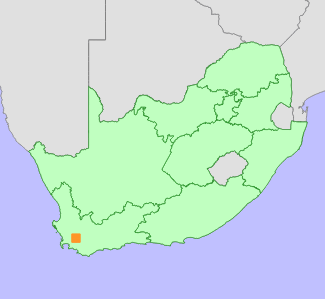| Scientific Name | Serruria rosea E.Phillips | Higher Classification | Dicotyledons | Family | PROTEACEAE | Common Names | Rose Spiderhead (e) |
National Status | Status and Criteria | Near Threatened B1ab(iii)+2ab(iii) | Assessment Date | 2019/02/05 | Assessor(s) | A.G. Rebelo, H. Mtshali & L. von Staden | Justification | Serruria rosea has a restricted distribution range, with an extent of occurrence (EOO) of 253 km², and an area of occupancy (AOO) of 112 km². Between 10 and 12 locations continue to decline due to ongoing habitat degradation. It therefore nearly meets the thresholds for Vulnerable under criterion B and is listed as Near Threatened. |
Distribution | Endemism | South African endemic | Provincial distribution | Western Cape | Range | This species is endemic to the Western Cape Province, South Africa, where it occurs from Du Toit's Kloof to the Riviersonderend Mountains. |
Habitat and Ecology | Major system | Terrestrial | Major habitats | Hawequas Sandstone Fynbos | Description | It grows in sandstone fynbos, 250-1000 m. Mature individuals are killed by fires, and only seeds survive. Seeds are released after ripening, and dispersed by ants to their underground nests, where they are protected from predation and fire. It is pollinated by insects. |
Threats | | A small proportion (4%) of this species' habitat was lost to pine plantations in the past. There is no longer any significant expansion of plantations, and therefore it is not an ongoing threat. Scattered alien invasive plants have been observed in this species' habitat around Du Toit's, Wemmershoek and Riviersonderend Mountains. If invasive plants are not cleared, they are likely to continue to spread and increase in density, eventually outcompeting this species.
Too frequent fires, which can result in local extinctions of reseeders when plants are killed before they are reproductively mature, has also been noted as a potential threat at some localities. This species is also susceptible to drought-related mortality. |
Population | Subpopulations of S. rosea are dense, isolated, with several thousand plants. More than 60% of this species habitat is conserved in the Hawequa Nature Reserve, but the biggest subpopulations occur under pine plantations. A continuing decline is inferred from ongoing habitat degradation.
| Population trend | Decreasing |
Conservation | | It is conserved in the Hawequa Nature Reserve. |
Assessment History |
Taxon assessed |
Status and Criteria |
Citation/Red List version | | Serruria rosea E.Phillips | NT D2 | Raimondo et al. (2009) | |
Bibliography | Goldblatt, P. and Manning, J.C. 2000. Cape Plants: A conspectus of the Cape Flora of South Africa. Strelitzia 9. National Botanical Institute, Cape Town.
Manning, J.C. and Goldblatt, P. 2012. Plants of the Greater Cape Floristic Region 1: The Core Cape Flora. Strelitzia 29. South African National Biodiversity Institute, Pretoria.
Raimondo, D., von Staden, L., Foden, W., Victor, J.E., Helme, N.A., Turner, R.C., Kamundi, D.A. and Manyama, P.A. 2009. Red List of South African Plants. Strelitzia 25. South African National Biodiversity Institute, Pretoria.
Rebelo, T. 2001. Sasol Proteas: A field guide to the proteas of southern Africa. (2nd ed.). Fernwood Press, Vlaeberg, Cape Town.
|
Citation | | Rebelo, A.G., Mtshali, H. & von Staden, L. 2019. Serruria rosea E.Phillips. National Assessment: Red List of South African Plants version . Accessed on 2025/04/18 |
 Comment on this assessment Comment on this assessment
|
Search for images of Serruria rosea on iNaturalist
|
 Comment on this assessment
Comment on this assessment

